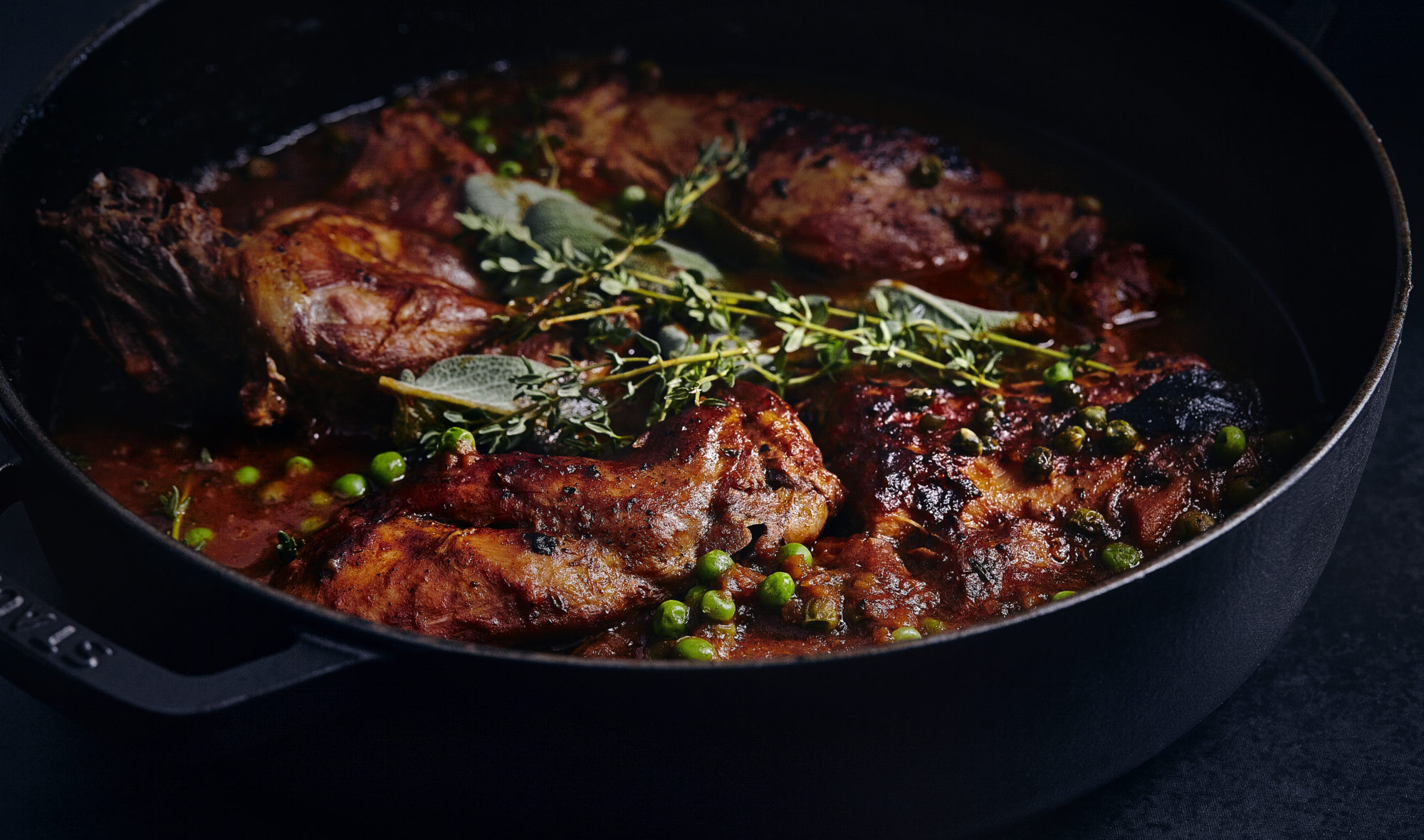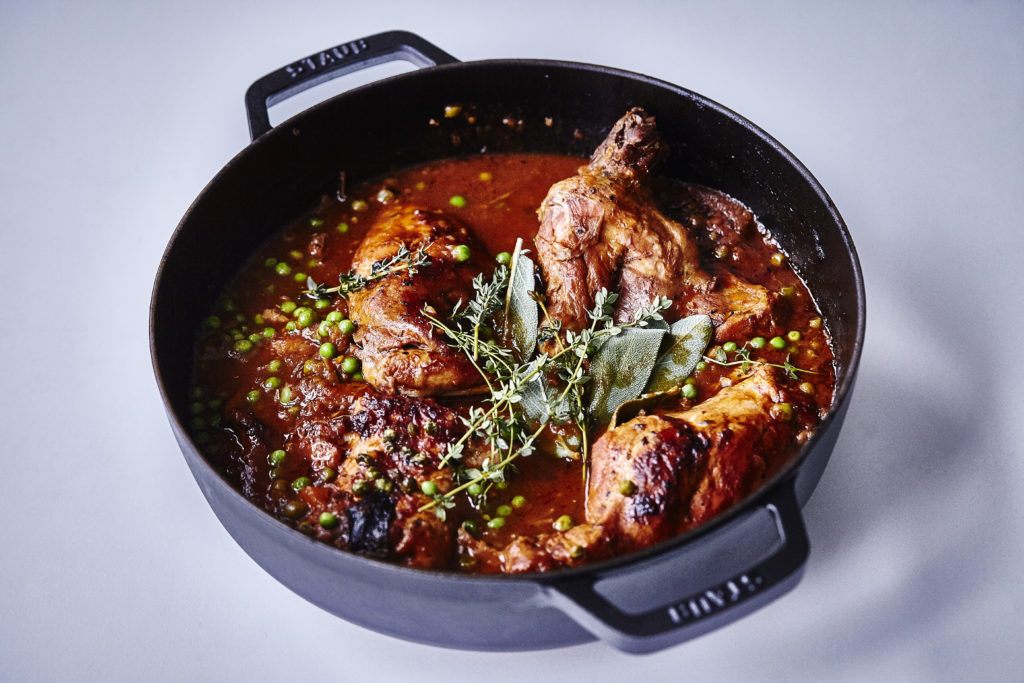
🎁 Holiday Special: SAVE 52% on the Nutrition Coach Starter Package. Limited number remaining.

🎁 Holiday Special: SAVE 52% on the Nutrition Coach Starter Package. Limited # left.

Rabbit is a lean meat with a neutral flavor. It is a relatively sustainable source of protein, given the prolific reproductive activity of the species. Although it’s not common fare in North America, it is quite common in European and Asian cuisine. Rabbit features particularly prominently in Szechuan cuisine, where it may be stir-fried or stewed in a spicy sauce, or barbecued. Rabbits may be categorized as “fryers” or “roasters”. Fryers are younger (up to nine weeks of age) and smaller (about 2kg). A fryer is a more tender and finer choice of meat. Roasters are older (up to eight months of age) and larger (over 2.3kg) and tend to have firmer, coarser flesh. Rabbit is exceptionally rich in protein and is also rich in vitamin B12 and iron. Although eating rabbit may sound exotic and adventurous, many culinary experts will assure you that it tastes much like chicken.
Although it’s not common fare in North America, rabbit is quite common in European and Asian cuisine.
Rabbit is a lean meat with a neutral flavor. It is a relatively sustainable source of protein, given the prolific reproductive activity of the species. Litters of 18 are not uncommon, and in a year and a half cycle, doe rabbits domesticated for breeding can produce up to 100 offspring!
Rabbits are related to hares, which are the wild version of the Leporidae family. Hares are typically larger and have darker flesh and a stronger, gamier flavor than rabbits.
Rabbit features prominently in Szechuan cuisine, where it may be stir-fried or stewed in a spicy sauce, or barbecued. Malta is the world’s highest consumer of rabbit, and China is the world’s biggest producer of rabbits.
Rabbit is almost always sold skinned and gutted, either fresh or frozen. It may be sold whole, or in pieces (such as loins, hind legs, shoulders, giblets, etc.).
Rabbit may be categorized as “fryers” or “roasters”. Fryers are younger (up to nine weeks of age) and smaller (about 2kg). A fryer is a more tender and finer choice of meat. Roasters are older (up to eight months of age), larger (over 2.3kg), and tend to have firmer, coarser flesh.
Rabbit meat will have a similar appearance to skinned chicken thighs. It will be pink, slightly shiny, with creamy colored fat. It also has a similar flavor to chicken, although slightly gamier.
Rabbit giblets are also available, such as liver, heart, and kidneys. These will each have a unique flavor, but will generally have a stronger flavor than the flesh.
Three ounces of roasted, domesticated rabbit (about 85g) has 167 calories, 24.7g protein, 6.8g of fat, and no carbohydrates, fiber, or sugar. Rabbit is an excellent source of vitamin B12 and a good source of iron.
Depending on where you are in the world, rabbit may be available everywhere meat is sold, or it may only be available on special order from a quality butcher or grocery store. Alternatively, sometimes you can purchase rabbit meat directly from a breeder at a farmers’ market. Always shop at trustworthy meat purveyors with a good reputation.
When choosing fresh rabbit, look for nicely colored shiny pink skin and cream-colored fat. If buying a whole rabbit, ensure that the legs are still flexible, which is a sign of freshness. If the head is still attached, check the eyes – they should be bright and clear. Avoid the rabbit if its skin appears bruised or if it has a bitter odor.
Freshly butchered rabbit can be stored in an airtight container or package in the fridge for two to three days, depending on when it was killed. Rabbit can also be stored in the freezer for up to four months, although some of the delicate flavor will be lost in this method.
Once cooked, rabbit can be stored in an airtight container in the fridge, and should be eaten within three to four days. Alternatively, cooked rabbit can be frozen for up to four months.
Rabbit can be prepared using a number of different cooking methods. It can be roasted, braised, stewed, fried, barbecued, or even baked into a savory pie!
Braising is an excellent way to prepare rabbit because this moist heat cooking method preserves moisture and tenderness in the meat.
Here’s how to braise rabbit (that’s already been butchered into pieces):
Place a large, lidded pot over medium-high heat, add a good glug of olive oil, and heat until simmering. Add rabbit pieces to the pot and brown, lightly salting each piece as you go. Once the pieces are browned, remove them and set aside. To the same pot, add one large sliced onion and four cloves of coarsely chopped garlic. Cook until onions are slightly caramelized, about 10 minutes, stirring frequently to prevent burning. Add the rabbit back to the pot, then add 1/3 cup of sherry vinegar, a few pinches of salt and pepper, and enough water to cover the rabbit pieces about halfway. Bring to a boil, then reduce to simmer. Cover the pot, and then continue simmering for about 90 minutes, or until rabbit is tender and juicy. Add other vegetables such as chopped carrots, potatoes, and peas if desired.

Much like chicken, rabbit has a very neutral flavor profile, and in some cases a hint of game. Treating it in a braise makes good sense to get a soft, delicious texture. Ask your butcher if they can cut the rabbit up into six equal pieces, to make it easier for you to hop right into cooking.
Prep Time: 30 minutes Cook Time: 180 minutes Yield: 4 servings
Preheat oven to 275 degrees Fahrenheit.
Begin by pulling the rabbit out of the fridge. Season the rabbit pieces with salt and pepper and let it sit for 20 minutes.
Heat an 11-inch braising pan over medium-high heat. Add 1 tbsp of olive or coconut oil to the pan. Fry the rabbit pieces until brown on the outside.
Once the rabbit is brown, remove it from the pan, and set it aside. Remove the pan from the heat to cool slightly. Remove the oil from the pan by cleaning it with a paper towel. Place the pan back on medium-low heat. Add 1 tbsp of olive or coconut oil and fry the onions, carrots, and fennel for about 5 minutes.
Add the tomato paste and smoked paprika. Cook and caramelize for about 5 minutes – the result should be a nice deep rust color. Pour in the stock and mix to combine. Add the herbs to the pan. Next, add the rabbit back into the pan and bring to a boil. Once it’s boiling, cover the pan and turn off the heat. Place the covered pan into pre-heated oven and cook for about 2 hours. At the 2 hour mark, carefully remove the pan from the oven, uncover, and add in the peas. Put the pan back into the oven, and cook uncovered for 30 minutes more.
Pull the pan out of the oven carefully with oven mitts. Carefully remove the rabbit pieces from the pan and place on a clean working surface or into a large bowl. Put the cover back on the pan to keep the sauce warm. You can certainly wait until the rabbit cools slightly to work with your hands however, you don’t want the rabbit to cool completely. Shred the rabbit, taking very good care to ensure all of the bones are removed (beware of the pesky little bones). Add everything back to the warm pot and give it a mix.
Serve over barley or rice, or eat it like a stew. Enjoy!
Precision Nutrition’s Encyclopedia of Food expands every single month as we highlight new foods and showcase beautiful food photography. If you’d like to stay up to date, simply click this link. From there, we’ll send you a FREE copy of our recipe book. We’ll also let you know when new and delicious foods are added to the site.
Rabbit is a lean meat with a neutral flavor. It is a relatively sustainable source of protein, given the prolific reproductive activity of the species. Although it’s not common fare in North America, it is quite common in European and Asian cuisine. Rabbit features particularly prominently in Szechuan cuisine, where it may be stir-fried or stewed in a spicy sauce, or barbecued. Rabbits may be categorized as “fryers” or “roasters”. Fryers are younger (up to nine weeks of age) and smaller (about 2kg). A fryer is a more tender and finer choice of meat. Roasters are older (up to eight months of age) and larger (over 2.3kg) and tend to have firmer, coarser flesh. Rabbit is exceptionally rich in protein and is also rich in vitamin B12 and iron. Although eating rabbit may sound exotic and adventurous, many culinary experts will assure you that it tastes much like chicken.